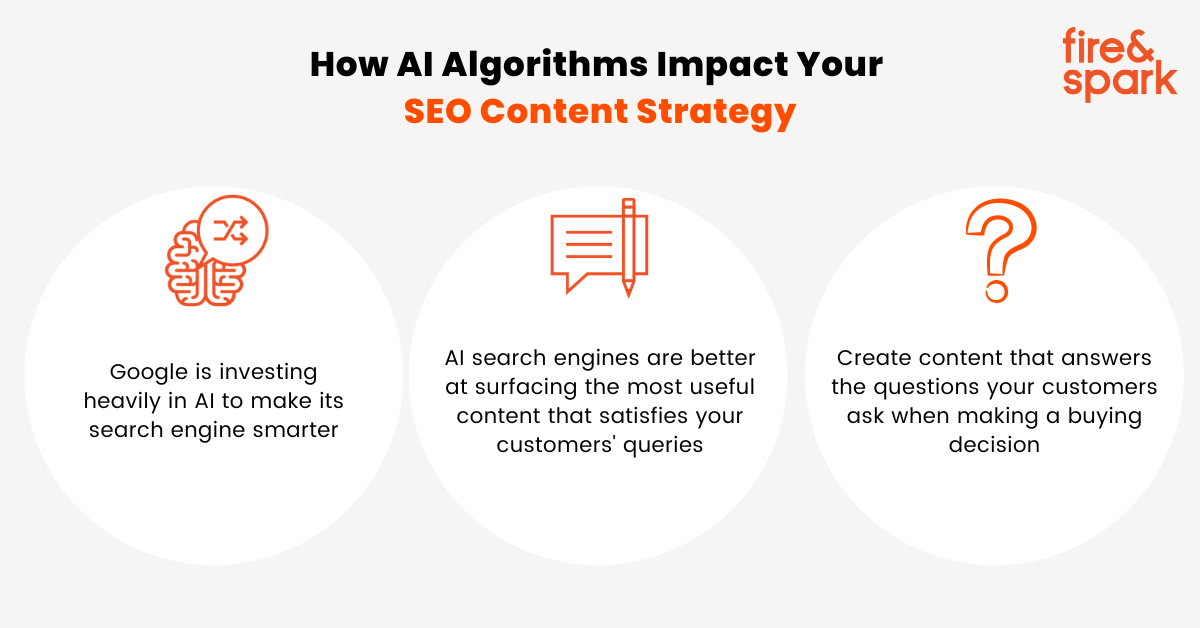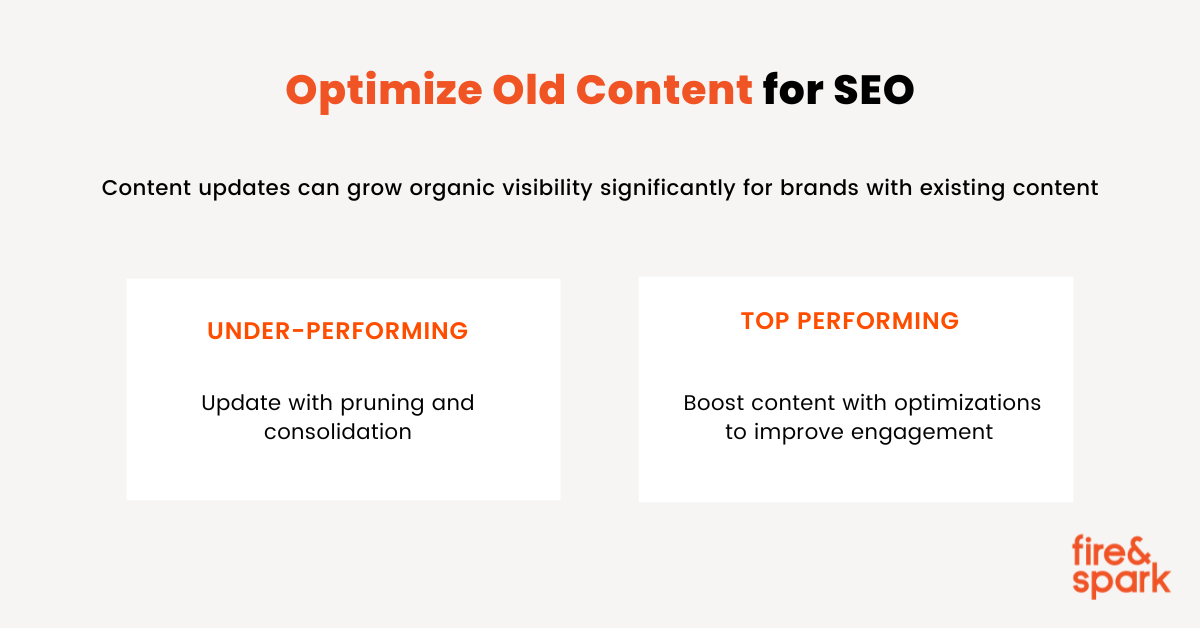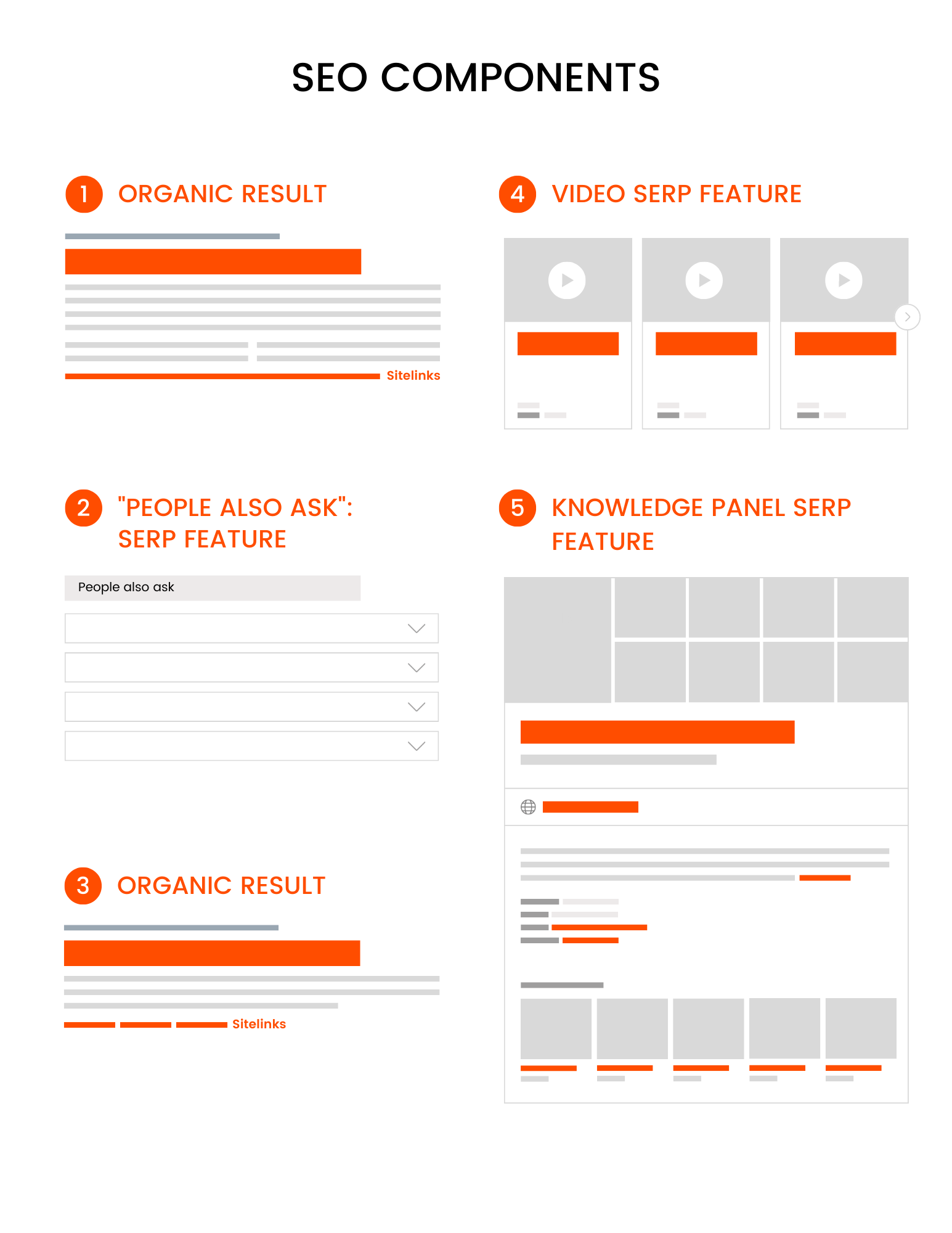Why is SEO so hard?
Google’s algorithm is constantly changing and that’s the main reason why SEO can be so challenging. A situation that a number of us find ourselves in is losing organic traffic after an algorithm update and struggling to gain it back.
Also, organic traffic is competitive. If other firms offer similar services to you, especially if they’re local, then there’s likely a ton of traffic and competition for high-value keywords.
Scaling SEO
To scale your SEO campaigns despite the challenges that come with the industry, we’ll walk you through 5 different opportunities:
- Stay ahead of the algorithm
- Deploy AI Tools
- Optimize existing content
- Adapt to Post-Covid Search Behavior
- Optimize for new search features
1. Stay ahead of the algorithm
It’s extremely important to understand where Google has been and where it is going in terms of how it’s ranking content and the type of content that it’s looking for, in order for us to do SEO effectively going forward.
Here’s what we know:
- Google is now investing heavily in artificial intelligence based algorithms which will help the search engine continuously get smarter and build better search engine results pages (SERPs).
- AI search engines are experts at surfacing the most useful content to satisfy searchers’ queries. The AI uses a number of factors to detect which content is deemed the most useful, such as websites with high clickthrough rates in the SERPs and pages with long sessions.
- Create content that answers the questions your customers ask when making a buying decision.

2. Deploy AI Tools
The marketing software that we’re all using is getting smarter because of AI technology. This is a trend across numerous softwares – HubSpot, Semrush, Ahrefs, Moz, and even marketing automation software.
Start by understanding which workflows of yours need the most help. Then, research if the tools you’re already using have AI for those specific pieces of your workflow. You can also search for new tools on Google. You may be surprised to find most of these already exist:
- AI for keyword research
- AI for publishing articles
- AI for writing outlines
AI tools can help, but not all of them will provide high-quality results. The key to finding a useful AI tool is to look for concrete things when evaluating the effectiveness of it (i.e can the AI actually write an outline on its own).

Get our free Guide to AI Tools for SEO and Content Marketing: Download now
3. Optimize existing content
A lot of people only think about developing content when we talk about SEO and content marketing. But, if your website already has existing content, there’s a huge opportunity to optimize the content you already have. This is actually a lot easier in many cases than to create new content.
When we say optimizing existing content, it really depends on how much content you have on your site. There are a number of firms who just don’t have that much content and should instead be focusing on new content to create. But, there are also many companies out there who have a bunch of content on their site – and these are the brands who have an opportunity to update their existing content.
How to evaluate existing content
One way to look at this is if you have content that is already performing well and you want to help it do even better.
Another scenario is if you have content that is constantly not performing well. In fact, it’s underperforming. But, you can easily consolidate this content in order to make it do better.
The last scenario is our favorite. Let’s say you have content that’s already ranking well for a specific keyword that you care about, but you’re at the bottom of the first page or the top of the second page of Google search results. In this case, you have an opportunity to move up higher in the results. This is what we consider low hanging fruit or low hanging keywords. These are usually the best opportunities to rank existing content.
Takeaways
- Businesses with existing web content can often grow their organic visibility significantly with content updates.
- Update your under-performing content with pruning and consolidation.
- Give your best performing content a boost with optimizations that improve engagement and optimization for new SERP features.

4. Adapt to Post-Covid Search Behavior
The world turned upside down thanks to COVID-19 and now more than ever consumers are depending on search engines to give them quick and accurate answers to their questions. Search behavior has changed and Google’s AI is now able to understand the search intent behind specific queries. If you want to create successful content for SEO, you must adapt to this shift.

Read more: How To Target Search Intent and Transform Your SEO
5. Optimize for new search features
It’s no secret that there are more features on the search results pages than ever before. These new features have, in some cases, taken priority in Google’s eyes and pushed the web results that we typically try to optimize for lower, reducing organic click-through rates even for the top websites. The good news is that marketers can optimize for these search features and potentially earn new ranking opportunities.
In the example below, notice how one keyword may not just rank for the “organic result” section of the SERPs, but also potentially for the “people also ask”, “video”, and “knowledge panel” features:

Takeaways
- Google has added many new features to the search results pages, in addition to ordinary web results.
- The new search features push ordinary web results down the page and reduce click-through rates.
- Featured snippets and ‘people also ask’ results are best targeted with Q&A style content.
- “Read the results” to identify the search features you should target.
Issues with Scaling SEO Campaigns
- Content creation – We need to create the right content and make sure it’s targeted towards our audience and the phase they’re at within the customer journey.
- Authority building – Prove to Google that we are trustworthy, have expertise, and the content we’re creating is accurate.
- Maintaining topical relevance – Make sure Google knows the types of products or services we offer to ensure we’re ranked whenever somebody is looking for those same types of products or services.
- Multi-region – Manage campaigns across an international audience and/or using various languages.
- Optimizing crawl and indexation – Make sure that Google can see all of the content we’re creating.
SEO used to be simple. Google would just look for keywords across web pages. But now, SEO has changed drastically and will continue to change. Marketers have no choice but to adapt to the new state of search.


